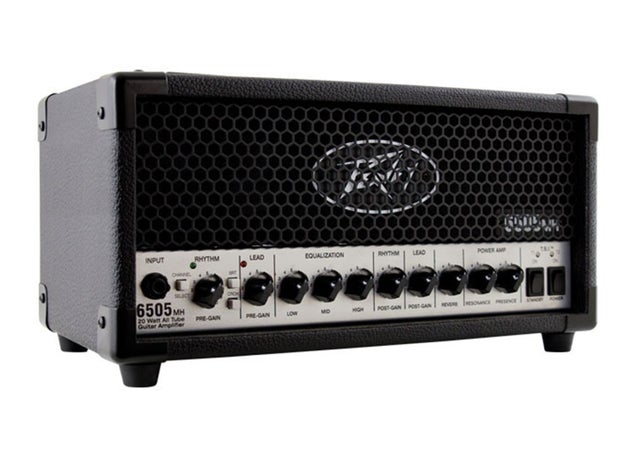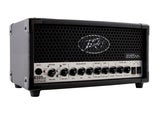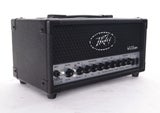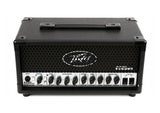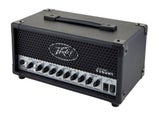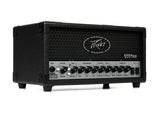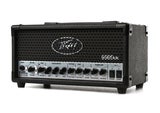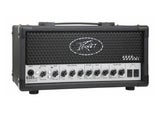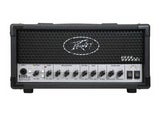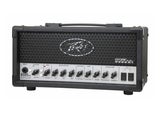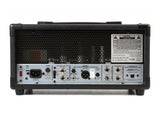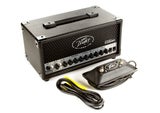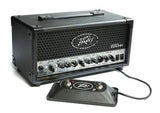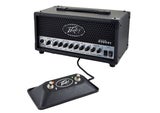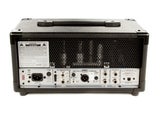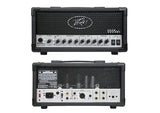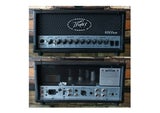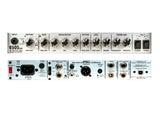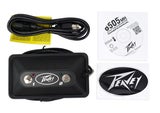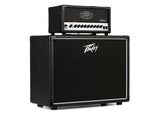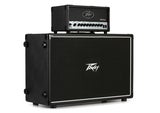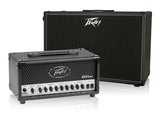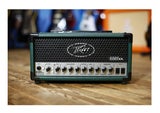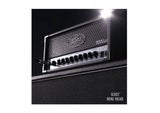- SHOP
- >
- GUITAR AMPLIFIER VALVE HEADS
- >
- NEAR NEW | STORE DEMO | USED | CLASSIC
- >
- Peavey® 6505™MH 20/5/1w 8/16-Ohm 2Ch All-Valve Guitar Amp Head w/- 2 x EL84 Power & 3 x 12AX7 Pre-Amp Tubes, Effects-Loop, Spk Defeat Switch, Cab Emulation MSDI™XLR (DI out) ★ NEAR NEW | USED ★ FREE FREIGHT | 1YR WARRANTY | LIMITLESS LAYBY | PAYPAL
Peavey® 6505™MH 20/5/1w 8/16-Ohm 2Ch All-Valve Guitar Amp Head w/- 2 x EL84 Power & 3 x 12AX7 Pre-Amp Tubes, Effects-Loop, Spk Defeat Switch, Cab Emulation MSDI™XLR (DI out) ★ NEAR NEW | USED ★ FREE FREIGHT | 1YR WARRANTY | LIMITLESS LAYBY | PAYPAL
SKU:
NTM-03614180-U
A$1,199.00
A$749.00
A$749.00
On Sale
Unavailable
per item
Peavey® 6505™MH 20/5/1watt 8/16-Ohm 2-Channel All-Valve Tube Guitar Amplifier Head w/- 2 x EL84 Power Tubes, 3 x 12AX7 Pre-Amp Tubes, Power Attenuator, Rhythm Pre-Gain w/- Bright Boost & Crunch Boost, Lead Pre-Gain, Shared Low/Mid/Hi EQ & Reverb, Rhythm Post-Gain, Lead Post-Gain, Master Resonance & Presence, as well as Effects Loop, 20/5/1w Power Switch, T.S.I.™ Standby, Cab Emulation Out, MSDI™ XLR (DI out), 2-Button Footswitch, plus an amazing 220v-230v / 240v∿ / 50-60Hz to 110v-115v / 120v∿ / 50-60Hz Voltage Switch (use it in ANY country!)
★ NEAR NEW | USED EXCELLENT ★ FREE FREIGHT | 1YR WARRANTY | LIMITLESS LAYBY | PAYPAL | NO INTEREST EVER Finance Available
______________________________________________________________________
Peavey® 6505™MH Mini Head 20/5/1-watt Tube Head
20/5/1-watt Tube Guitar Amplifier Head with 2 Channels, 3-Band EQ, Direct Out, Effects Loop, Reverb, USB, and Headphone Out
Aggressive Tone and Gig-focused Features
Peavey's 6505™MH mini tube amp head packs all the tonal tenacity that the 6505™ Series is known for, and it's got what it takes to be a gig-worthy guitar amp, too. You'll never have to worry about showing up to a gig with bad power tubes, because the Tube Status Indicator tells you how they're doing at a glance. Send your tone directly to the PA system with the Mic Simulated Direct Interface, with a speaker defeat switch to turn off your cabinet for lower stage volume (or for silent practice with headphones). And with footswitchable channels, crunch, reverb, and effects loop, you've got all the flexibility you need with the 6505™MH.
Peavey® 6505™MH Tube Guitar Amplifier Head at a Glance:
More versatile than some 2-Channel amplifiers
Perfect for creating your own rock and metal guitar tones
Designed for long-term performance
More versatile than some 2-Channel amplifiers
With two footswitchable channels, the Peavey® 6505™MH sets a solid foundation for most rockers and metal guitarists. Each channel has separate pre- and post-gain controls for fine-tuning your tone. And the rhythm channel also has a footswitchable crunch mode that's perfect for putting some hair on a clean tone. Factor in a footswitchable reverb and effects loop, and you've got a lot of flexibility in the 6505™MH.
Perfect for creating your own rock and metal guitar tones
We've had the great opportunity to get to know Hartley Peavey here at Sweetwater, and we know that Peavey approaches guitar amp design with the goal of making the amps sound as unique as your playing style. The Peavey® 6505™MH definitely has an aggressive sound to it, as well as a fast and sensitive response, but it doesn't have a specific, defined voice. Spend some time with it, and you're sure to come up with a sound that is distinctly yours.
Designed for long-term performance
We keep referring to the 6505™MH as a gig-ready amp, and we mean that Peavey designed this guitar amplifier with long-term performance in mind. Proper tube maintenance isn't the favourite activity of any guitarist, so the Peavey® 6505™MH's Tube Status Indication makes it much easier to make sure your amp is always ready to rock. We know that sometimes a direct output is a much better solution than miking up your cabinet, and the 6505™MH 's Mic Simulated Direct Interface makes it easy to plug directly into the PA with respectable tone. From practice to recording to performance, the Peavey® 6505™MH is the kind of amp you can count on.
Peavey® 6505™MH Tube Guitar Amplifier Head Features:
Mini tube amp head with switchable 20-watt, 5-watt, or 1-watt operation
Inject great tone directly into the PA system with the Mic Simulated Direct Interface
USB output for easy recording directly to your DAW
Tube Status Indication lets you know your power tubes are still working properly
Footswitchable channels, crunch, effects loop, and reverb
Find your tone with the Peavey® 6505™MH mini tube amp head!
______________________________________________________________________
Tech Specs
Type: Tube
Number of Channels: 2
Total Power: 20W/5W/1W
Preamp Tubes: 3 x 12AX7/ECC83
Power Tubes: 2 x EL84
Reverb: Yes
EQ: 3-band
Inputs: 1 x ¼"
Outputs: 1 x ¼" (speaker), 1 x XLR (direct out)
Headphones: 1 x ⅛"
Effects Loop: Yes
USB: 1 x Type B
Footswitch I/O: 2 x ¼" (channel/crunch, reverb/loop)
Footswitch Included: Yes, 2-button footswitch
Construction Material: Black Tolex
Power Source: Standard IEC AC cable
Height: 7.25"
Width: 14"
Depth: 7.75"
Weight: 17 lbs.
Manufacturer Part Number: 03614180
______________________________________________________________________
Peavey® 6505™Series "6505™MH"
Mini Metal 20w Guitar Amplifier Head
A Peavey® 6505™ in a Small, Portable Package
Although small, this amp has an all-tube preamp and power amp to authentically produce the much loved tones of the iconic larger models on which it is based, albeit at lower power levels. The major advantage is the sheer (or lack of) size and weight.
Forging the sound of aggression for more than two decades, the Peavey® 6505™ Series of amps produce the devastating overdriven tones that modern players demand. Peavey proudly introduces the 6505™MH, as a part of its ‘micro-head’ series. Although all are inherently versatile, each of the models feature very different preamp voicings and gain structures. We are confident that everyone from a country picker to a metal shredder will find at least one of these will work for them.
There are numerous features, several that are unique to Peavey, that are described in more detail in the manual. In summary:
All models have two channels that follow the same gain structure and voicing of the larger amps on which they are based, as well as a boost function that has been designed for the specific model. The channels share EQ, lush reverb and an effects loop. Channels, boost, effects loop and reverb are all footswitchable. The back panel of the 6505™MH is full of modern technology, including Peavey's exclusive Microphone Simulated Direct Interface (MSDI™) with XLR output, USB recording output, headphone output, speaker defeat switch, plus a built-in 3 position power attenuator! T.S.I.™ tube monitoring constantly lets you know that your power tubes are in good shape, and if not, which ones need to be replaced.
The 6505™MH exhibits a tremendous amount of versatility in a small package; it features real tube tone, real tube power! It contains no simulations, emulations, or approximations. Before you begin playing through your amplifier, it is very important to ensure that the product has the proper AC line voltage supplied. This is shown on the voltage selector switch near the IEC inlet on the rear panel of the unit.
Features:
______________________________________________________________________
PEAVEY® 6505™MH MINI
GUITAR AMP HEAD
From Andertons Music Co, UK
The Peavey® 6505™MH is a miniature recreation of the incredible 6505™ for those that don't need the full 120w powerhouse. Rated at 20w this little desktop friendly amplifier is perfect for those that need an for home and studio use. Add in some powerful new technology and you have a great value amplifier that will deliver tones that are second to none.
The Icon
Based on the original Peavey® 6505™, the 6505™MH has a lot to live up to. Its big brother is well known as one of the greatest metal guitar amps ever made with an insane amount of saturation and a tight, “bitey” tone that will cut through any metal mix.
This amplifier matches up to its big brother perfectly just in a much smaller, much quieter fashion. Even after changing the tubes from 6L6 to EL84s they geniuses at Peavey have worked out how to keep as much of the original tone as possible.
Sweet Tech!
Making smaller versions of very loud heads has become really common in the last few years. Peavey didn't just want to leave it as a small clone and ship it out when they have new tech to show off. So not only does this amplifier have more I/O than you can shake it a stick at but it also gives you more information than ever before.
T.S.I.™ tube monitoring can be found on the front of the amplifier and this lets you know the condition of your power amp tubes at any time. It could be that they are running a bit hot or need replacing soon, either way having this knowledge is how you will keep this amp working gig after gig.
Between Peavey's MSDI™ Mic simulated output, a direct USB output, Headphone outs and even a 3 point attenuator you really can take this amplifier anywhere from the bedroom to the stage. One of the coolest parts of this circuit is the mute switch though. Very few valve amps have a way to safely mute the speaker while still delivering high quality simulated audio through your cans but this does it.
Here's what Peavey say about the 6505™MH
Featuring an all-tube preamp and power amp, the 6505™MH authentically produces the much loved tones of the legendary Peavey 6505 in a small, portable package. The 6505™MH has two channels that follow the same gain structure and voicing of its big brother! The channels share EQ, lush reverb and an effects loop. Channels, crunch, effects loop and reverb are all footswitchable. T.S.I.™ tube monitoring constantly lets you know that your power tubes are in good shape, and if not, which ones need to be replaced. The back panel of the 6505™MH is full of modern technology, including Peavey's exclusive MSDI™ output, USB recording output, headphone output, speaker defeat switch, plus a built-in power attenuator!
Written by
Jed Van Wyngaardt
Specifications
2x EL84 power tubes and 3x12AX7/ECC83 preamp tubes
Two footswitchable channels with 3-band EQ
Footswitchable crunch on Rhythm channel
Footswitchable reverb
Footswitchable buffered effects loop
Tube Status indication (T.S.I.™) circuit
MSDI™ Output with XLR and ground lift switch
USB output
Speaker defeat switch
Headphone output
Attenuator switch for 20 watts, 5 watts, or 1 watt output power
Impedance switch for 16 or 8 Ohm cabinets
Weight Unpacked: 16.64 lb (7.55 kg)
Weight Packed: 20.50 lb (9.3 kg)
Width Packed: 13.125" (33.3375 cm)
Height Packed: 19.375" (49.2125 cm)
Depth Packed: 12.375" (31.4325 cm)
______________________________________________________________________
MusicRadar
THE NO.1 WEBSITE FOR MUSICIANS
Peavey® 6505™MH Review
Do the best things come in small packages?
By Nick Guppy (December 07, 2015)
OUR VERDICT
Metal and modern-rock players should make a beeline for the 6505 with its huge overdrive capability and lightning pick response.
PROS
CONS
These include separate rhythm and lead preamp and master volume controls, low, mid and high EQ, a bright switch on the rhythm channel, power stage presence and resonance, together with a footswitchable crunch mode for the rhythm channel.
Rear-panel features are identical to the other two mini heads, with the same speaker, DI, loop and footswitch functions.
Despite having significantly different sounds, all three heads have a similar 'family' look, as the cabinets are all the same size and share Peavey's typically high build and finish quality.
The 6505™ is even more focused, aimed squarely at modern rock and metal players. It's a bang-up-to-date version of the amp formerly known as the 5150™, a popular choice for rock and metal users all over the world, and not just because of the Van Halen association.
This amp's bone- crushing thick distortion is the product of a lot of preamp gain stages and a powerful resonance control that boosts the low-end response. While it has less than half the preamp valves of its full-sized big bro, it still sounds remarkably similar, with the same full bass response and OTT crunch sounds that eclipse most players' notions of a good metal lead sound.
The 6505™'s lead channel squeezes out even more grind and sustain for a superlative rock and metal sound, although like the original, it takes some dialling in to achieve the best results.
All three amps in the Mini Head impress with their similar back panel features: the MSDI™ output sounds quite realistic and delivers a good clean signal to live or studio desks, while the USB connector works faultlessly on our Win7 PC DAW. A good word is due for the built-in reverb, too, which sounds a lot more expensive than it is and easily frees up an outboard digital effect.
Peavey's manufacturing and design expertise has been fully leveraged with these three heads; they look great and sound very impressive, with power and clean headroom to handle most smaller gigs, and studio-friendly features that make a huge difference when it comes to getting tracks down fast. The price is reasonably competitive, bearing in mind these are all real valve amps and all three heads look and sound anything but bargain basement.
______________________________________________________________________
Guitar World
Review: Peavey 6505™MH Guitar Amp
By Chris Gill (April 15, 2016)
GOLD AWARD
In the not too distant past, there was a rather significant rift between big and small guitar amps.
Big amps had the advantage of being really loud and versatile with the disadvantage of being very expensive, while small amps offered players great tone for affordable prices but a rather limited set of tone controls and features.
In recent years, mini amp heads have packed an increasing amount of features into their diminutive frames, and many deliver tones that compete with full-size amp heads, but the cost has also increased rather significantly at the same time.
With their new 6505™MH amp (with MH meaning “mini head”), Peavey has reversed the trend of ever-increasing mini amp prices by offering a truly affordable, versatile amp packed with numerous useful features rivalling those of full-sized amps.
FEATURES
Based on the best-selling 6505™ amp head, the 6505™MH offers the same gain structure and voicing and similar features (as well as a few new, exclusive features) in a significantly smaller package. The 6505 has a two-channel design and is driven by a pair of EL84 power tubes and three 12AX7 preamp tubes, providing 20 watts of output. The Rhythm and Lead channels are individually voiced to provide ample clean headroom and high-gain distortion respectively. The Rhythm channel also includes its own pre-gain and post-gain controls, bright switch, and crunch switch (which can be engaged via a footswitch), while the Lead channel also features a separate set of pre- and post-gain controls. Both channels share the low, mid, and high EQ control section, and the master/power amp section features reverb, resonance, and presence controls.
The features on the 6505™MH’s rear panel rival those of many full-sized flagship model amps. The Mic Simulated Direct Interface (MSDI™) includes an XLR output jack, ground lift switch, headphone jack, and a speaker enable/defeat switch that engages a load circuit so you can use the amp without speakers without damaging the transformers and circuitry. There’s also a mic simulated USB audio jack for connecting the 6505 MH directly to a computer. Other features include a mono effect loop, ¼-inch speaker output with 8-/16-Ohm switch, and a slider for 1-, 5-, or 20-watts of output. An included dual-footswitch controller can operate either Channel/Boost or Reverb/Loop functions, or both if an additional footswitch controller is purchased.
PERFORMANCE
The Peavey® 6505™MH may be rather small when it comes to dimensions and weight, but its sound is absolutely massive. The rhythm channel produces very impressive clean headroom as well as aggressive, ballsy crunch tones with plenty of chunk and chime. The lead channel takes over a little beyond where the rhythm channel’s most rowdy setting leave off, providing delicious high-gain distortion with impressive low-end thump. Whereas many small amp heads can sound fizzy, buzzy, and compressed with the preamp gain maxed out, the 6505™MH delivers dynamic punch and gutsy attack just like its big brother.
The amp’s controls are very versatile but also interactive, so dialling in desired tones can require bit of tweaking trial and error, particularly at the 1-watt setting where the resonance and presence controls can really make a big difference. While some may view the shared EQ section as a limitation, the rhythm and lead channels are voiced similarly enough that it’s easy to dial in EQ settings that sound great on both channels. The built-in digital reverb is a welcome addition, but because it’s more of a plate-style reverb than room or spring, I found that a little went a long way, and it was best to keep the reverb control no higher than 10 O’Clock.
LIST PRICE US$599.99
MANUFACTURER Peavey Electronics,
peavey.com
• The rhythm channel provides impressive clean headroom while the lead channel delivers the famous high-gain distortion that made the original 6505™ a legend.
• The MSDI™ section allows users to connect the amp directly to a mixing console without a speaker cabinet for recording or live performance applications.
THE BOTTOM LINE
Priced less than many mini heads with less output power, features, and versatility, the Peavey® 6505™MH is an absolute steal that delivers gig-worthy volume output and a multitude of world class tones ideal for the biggest stages and studios.
The Reviewer: Chris Gill
Chris is the co-author of Eruption - Conversations with Eddie Van Halen. He is a 40-year music industry veteran who started at Boardwalk Entertainment (Joan Jett, Night Ranger) and Roland US before becoming a guitar journalist in 1991. He has interviewed more than 600 artists, written more than 1,400 product reviews, and contributed to Jeff Beck’s Beck 01: Hot Rods and Rock & Roll and Eric Clapton’s Six String Stories.
______________________________________________________________________
► CUSTOMER REVIEWS
Peavey® 6505™MH Head Review
Overall Average Rating: ★★★★★
(5 out of 5 Stars)
★★★★★ My First Tube Amp
After a lot of online research, and comparison to other mini amp heads, I decided on this one for not only the sound it gives, but all the features it has. I am really liking my first tube amp! Great buy! And as always, NTM staff are the best!
by Billy Starr from Arlington, TX (August 12, 2018)
Rated 5/5
★★★★★ Awesome little Amp
Paired this thing with an invective™.212 2x12 cab and it’s just gorgeous tone very impressed with its volume and thump, loud enough to play live with a drummer no problem. I play in a 5 piece hard rock /metal band and its perfect.
Now this thing will get pretty clean, despite what some of the other reviewers say, you have to know the pre-post relationship (- the pre is the dirt, - the post is volume, to put it simply) just crank the Post-Gain almost all the way and use the Pre-Gain- for volume - you shouldn’t half to crank the pre at that point for volume and that WILL give you a Very usable clean - not Fender® of course but very usable.
by Nick from Stockton, CA (January 12, 2018)
Music background: Experienced musician
Rated 5/5
★★★★★ Awesome for Modern Metal Tone
This thing is insanely awesome at all volumes. I get the perfect modern metal tone going into a closed-back MESA 2x12" (V30's) with a noise gate and OD in front for boost. You cannot beat this tone for the price.
by Customer from Oakland, CA (January 4, 2018)
Music background: Metal Enthusiast
Rated 5/5
★★★★★ 6505 Mini Head
This thing is awesome. Killer metal tone in a little package. I have it on an Orange® 2x12 with Celestion® Vintage V30’s. Love it.
by Customer (November 23, 2017)
Rated 5/5
★★★★★ Metal Monster
If metal is your medicine look no further, this is the ticket. This thing sounds soooo sweet with Peavey® 112-6 cabinet playing on 5 watts you can really drive the tubes without blowing out the house. All the overdrive you could ever want, no kidding!
by Larry from Norcal Bay area, CA (July 1, 2017)
Music background: 30+ years banging out metal
Rated 5/5
★★★★★ Guitar / Classic Rock
The rhythm channel has a great crunch tones for some old time rock and roll, and even then I find myself rolling back the massive amount of gain this thing has.
The lead channel made for some delicious high-gain distortion, more gain then anyone will ever need in an amp. Impressive low-end and mids cut right through the mix when recording playing.
The shared EQ took some time getting used to, I tend to usually just roll back the volume on my guitar or use an acoustic guitar simulator pedal that makes the cleans perfect.
The headphones is a nice touch for those late-night practices/solo jamming when you don't want to disturbed people around you. Great for people who are awake all night like myself.
The USB recording is horrible. Only way I see any use out of this is when you want to quickly connect to a PC to record an idea you don't want to forget for later.
by Edin from Astoria, NY (June 21, 2017)
Rated 5/5
★★★★★ Incredible
I have used numerous Blackstar®, Marshall®, Randall®, Orange®, and other Peavey® combo amps and this one does it all, but better. Some amps sound good at low volumes, and terrible at high volume and some vice versa. The 6505™MH sounds great at all levels and offers a wide range of tones except super clean, but I knew that before I purchased it, as I don't play clean normally anyway. Absolutely no need for a gain pedal, because there is more than enough on tap, and that's coming from someone who couldn't have enough gain with previous amps. Crunch channel sounds awesome too and the presence and resonance controls really help add to sculpting the tone with either channel. The wattage selector switch is what initially caught my attention with this head. I can set it on one watt and have awesome tone practicing without disturbing anyone else in the house. Or I can switch to 5 watts for more volume, and up to 20 watts to use live if I chose to. Only feature that would make this amp better might be MP3 plug in capability. Besides that, I couldn't be happier with this amp.
by Kevin from Connecticut (December 27, 2016)
Rated 5/5
______________________________________________________________________
PEAVEY® - We Are Innovation. Amplified.
Driven by an unmatched legacy of innovation and a total dedication to quality and reliability, Peavey Electronics embodies the pursuit of perfection in music and audio. It's our unifying spirit. It's proven - and it continues today.
For nearly five decades, Peavey has blazed its own path toward musical perfection. Founded by Hartley Peavey in 1965 as a one-man shop, today Peavey Electronics Corporation is one of the largest makers and suppliers of musical instruments, amplifiers and professional audio systems in the world—distributing more than 2,000 products to more than 130 countries.
Hartley has famously said, "In order to be better, by definition you must be different." What makes Peavey different is a commitment to approaching business with a unique vision, from product design to distribution to being the largest independently owned manufacturer in the business. His quest has led to more than 180 patents and innovations in the way we hear and play music.
Hartley Peavey is not only the visionary, lead engineer and chief executive, but also the lynch pin that connects a rich history to a bright future. And his founding principles of quality, reliability and innovation are still the focus of engineering and manufacturing operations that span continents and languages, customs and cultures.
______________________________________________________________________
PEAVEY ELECTRONICS - CORPORATION HISTORY
Company Perspectives
Since its founding in 1965, our company goal has always been to build the best products available while at the same time making them affordable through the use of the most modern computer-assisted design manufacturing methods available.
Company History
The Peavey Electronics Corporation, founded in 1965 by Hartley Peavey, is a major manufacturer of guitars, amplifiers, speakers, electronic keyboards, and other electronic audio-enhancement equipment. In 1993, the company, solely owned by Hartley, then chairman, and Melia Peavey, his wife and president of the company, had sales estimated at $210 million. Exports to more than a hundred countries accounted for an estimated 40 percent of sales. Peavey® Electronics, with more than 1,600 different products, is also the tenth largest manufacturer in Mississippi, with more than a million square feet of warehouse and manufacturing space in east-central Mississippi, including a 40-acre headquarters site known as Peavey City in Meridian. The company also has manufacturing operations in Foley, Alabama, and in Corby, England, and distribution centres in The Netherlands and Canada. Its chief competitor is Yamaha, the Japanese conglomerate. Founder Hartley Peavey, whose "hometown boy makes good" story made him a local legend in Mississippi, has been the recipient of numerous awards for entrepreneurship, including the "E Star" award for success in international markets from the U.S. Department of Commerce. He was also inducted into Hollywood's "Rock Walk of Fame" in 1990 for his contributions to rock 'n' roll music.
Musical Ambitions in the 1950s
Hartley Peavey grew up in Meridian, Mississippi, and had early aspirations of becoming a rock 'n' roll guitar player. As a teenager in the late 1950s, he worked in the Peavey Melody Music Store, owned by his father, J.B. "Mutt" Peavey, and tinkered with building amplifiers for local musicians. When, as he once confessed to Inc. magazine, he turned out to be a "pretty lousy guitarist," Peavey decided his future was in making amplifiers.
In 1965, after graduating from Mississippi State University with a degree in marketing and management, Peavey, then 23, took the remaining $8,000 in his college fund and formed Peavey® Electronics, working out of his parents' basement. As he later recalled in "Music and Sound's Greatest Hit," published by Peavey Electronics for its 25th anniversary: "I would build one (amplifier) a week, go out and sell it, come back and start on another one." The amplifiers were inscribed with the lightning bolt logo that Peavey had designed as a college freshman.
A year later, Peavey moved the business from the family's basement to an attic in the building that had housed his father's music store. By then, his father had sold the music store but still owned the building. Peavey also hired his first employee, a salesman, so he could concentrate on building amplifiers.
In the mid-1960s, however, there were many larger, better-known companies making amplifiers, and Peavey soon expanded into building public address systems to keep his young business afloat. In the company's 25th anniversary retrospective, Peavey explained that as "I travelled and talked to music dealers, I realised there was no shortage of instrument amplifiers. But if you wanted a PA system there were essentially only two available and both were expensive systems.... Most folks think I got into the music business with guitar amps. Not necessarily so!"
Staying in Meridian
By 1968, business was good enough that Peavey decided to borrow $17,500 to build a small "factory" in Meridian. Over the next five years, Peavey Electronics enlarged the building seven times, and having grown to more than 150 employees, in 1973 the company began construction on Plant #3, which would become its main manufacturing facility. To hire enough skilled employees, Peavey Electronics established training courses at Meridian Community College.
Over the years, Peavey was often asked about his decision to keep the company in Meridian. In 1985, he told Inc. that Mississippi "unfortunately runs dead last in everything. You don't have the skilled people you need; you don't have the suppliers; you don't have the access to the freight network.... Back in 1965, when I got into this, I was too damn dumb to know it couldn't be done." He went on to say that he had "lost count" of how often he wished he had built Peavey Electronics somewhere else. In a later interview with his hometown newspaper, The Meridian Star, Peavey explained, "What I tried to say in the Inc. article was that Mississippi presented many difficulties in starting a high-tech business. And some of these difficulties exist to this day." In 1982, the City of Meridian honoured its hometown industrialist by proclaiming April 21 as Hartley Peavey Day.
In the late 1980s, when the company was considering building its first U.S. manufacturing facility outside of Mississippi, then-Governor Ray Mabus worked with Peavey Electronics and Meridian Community College to create The Meridian Partnership, the first private-sector use of the Job Skills Education Program, a technology and basic-skills program originally developed by the U.S. Army. In the early 1990s, Peavey Electronics opened a 58,000-square-foot training centre, complete with its own recording studio, for its employees and more than 1,200 dealers. In 1993, Peavey told The News in Boca Raton, Florida, where he and his wife had a second home, "People ask me why Mississippi and I say, where do you think rock 'n' roll was born?"
Vertical Integration in the 1970s
It was in the early 1970s that the company began the vertical integration that would make it unique among major electronic musical equipment manufacturers. Unable to purchase reliable speaker components for its high-power amplifiers, Peavey Electronics began making its own loudspeakers. Eventually, Peavey Electronics would build everything it needed for its musical instruments, from cabinets and metal work down to making its own circuit boards and running its own advertising agency.
In 1990, Peavey explained, "If somebody local had been able to subcontract for me the things I needed to build amplifiers, I would probably still be using subcontractors. We had to learn to make our own chassis, our own circuit boards, and eventually everything 'in-house.' And while we thought it was a tremendous disadvantage, and in many ways, it was, we discovered that it was the best thing that could have happened."
In the mid-1970s, Peavey Electronics also began manufacturing electric guitars, again more from necessity than design. Several leading electronic instrument companies were gobbled up by conglomerates during the 1960s, including Fender Musical Instruments, which was purchased by CBS in 1964. These companies, with their immense marketing power, began encouraging dealers to sell their guitars and amplifiers as a package deal, cutting into sales of Peavey amps.
As he had when he adopted solid-state components for his first amplifiers, Peavey embraced state-of-the-art technology to produce guitars at lower cost, becoming the first manufacturer to use computer-controlled machinery to turn out guitar bodies and precision parts. Years later, Peavey recalled, "When we announced that we were making guitar bodies on computer-controlled machinery, some of the most prominent names in the industry said, 'Impossible. Everybody knows you can't make guitars with a computer.' That was a rather simplistic attitude, we thought, because, in fact, we weren't making guitars on computers. We were using ...computer-controlled machines to make precision guitar parts to tolerances that heretofore manufacturers couldn't even think about approaching. Guitar makers are always talking about hand craftsmanship. What hand craftsmanship is, in many instances, is the ability to fit together parts that are produced with a lot of 'slop' in them."
In the early 1990s, Peavey Electronics would establish a Computer-Integrated Manufacturing (CIM) system to link and track all aspects of its manufacturing, and increasingly the company was using robotics in its assembly processes. The company, however, had an unofficial no-layoffs policy and employees whose jobs were eliminated by technology were retrained for other positions. In 1994, Jere Hess, then director of public relations, told The Meridian Star, "No one in this company has ever lost their job because of automation."
Twenty-Fifth Anniversary
When Peavey Electronics celebrated its 25th anniversary in 1990, The Meridian Star published a 40-page special edition to honour the company that had become the area's largest employer. The newspaper noted that Peavey Electronics created more than 1,000 new jobs in east-central Mississippi between 1980 and 1989, including more than 850 in the Meridian area, and 73 percent of all new manufacturing jobs in Lauderdale County. Among those saluting the company was Mayor Jimmy Kemp, who said, "Of course the obvious things you think about when somebody in your community employs 1,850 people is the enormous impact it has on your city, which is fantastic. I'd hate to think what we'd do without Peavey Electronics as far as our city is concerned." Peavey Electronics was then the tenth largest manufacturing employer in the state.
In 1991, Peavey Electronics was one of 20 companies selected by the U.S. Department of Commerce to participate in a five-year program designed to stimulate export of U.S. products to Japan. As part of the program, the Department of Commerce arranged meetings between heads of the U.S. companies and Japanese officials, including Prime Minister Toshiki Kaifu and Minister of International Trade and Industry Eiichi Nakao. Peavey Electronics, which first entered the Japanese market in the mid-1970s in a short-lived relationship with industrial giant Yamaha Corporation, also agreed to participate in at least one trade show a year in Japan. Although the company contracted with other distributor, Japan was never a significant market.
In 1991, President George Bush chose Peavey Electronics as the site to give a speech on economic growth. The Meridian Star noted, "Hoping to pump fresh air into his sagging popularity, President Bush hailed the success of Meridian's Peavey Electronics Co. as proof that Americans can excel in a worldwide economic battle." The newspaper also quoted Peavey as stating that the company's "one real goal, perhaps unreachable, is to become a $1 billion company." At the time, Peavey Electronics was reported in the local media to have sales approaching $500 million a year, although company executives said that figure was greatly exaggerated. As a matter of policy, the privately held company did not release financial information, but annual sales in the mid-1990s were generally believed to be about $200 million to $220 million.
______________________________________________________________________
A Brief History of Peavey Amplifiers –
A Legacy of Quality & Affordability
The story of how Peavey became one of the largest audio manufacturers in the world is one of humble beginnings and a well-deserved reputation for quality, value and innovation. Growing up as a guitar or bass player, you’ve probably owned or played your fair share of Peavey amps, since the company’s catalogue is so affordable, diverse and well distributed.
After graduating from Mississippi State in 1965, Hartley Peavey started his company above his father’s music store, building amps one at a time. Since then, Peavey has proven to be a pioneer in all facets of solid-state and tube-driven amplification, which has led to the design of some of the world’s best and best-selling amplifiers, including the Bandit and the 5150®.
Not only is the company passionate about sound, it is equally passionate about build quality and affordability. Peaveys are known for their innovative circuitry, being built like tanks and for being affordable enough for musicians at every level, across the globe.
Humble Beginnings
In 1961 Hartley Peavey made his first amplifier and adorned it with the instantly recognisable company logo, which he designed himself in high school. When he launched the company four years later, Peavey produced only two amplifiers: The Musician and Dyna Bass. Both models were high-wattage, solid-state amplifiers that included simple features for the working musician.
In 1973, Peavey began development on a series of vintage Fender Twin inspired amps, with 6L6 power tubes and two 6C10 pre-amp tubes. These amps had a different sonic signature than the Twin and had their own unique sound. Since solid state was all the rage back in the 1970s, later versions capitalized on new technology, which enabled the combination of solid-state pre-amps with tube power amps.
The vintage series was the precursor to the now popular all-tube Classic Series®, which features an EL84 power section that effectively combines classic Vox- and Fender-type tones in one convenient and versatile amp for use in many different styles of music.
Solid State Dominance
With solid state amps becoming increasingly popular in the ‘70s and early ‘80s, Peavey developed what is arguably its most famous solid-state amp: The Bandit®.
Conceived in 1980, the Bandit since has gone through many revisions and Bandit®s still are being produced today with Peavey’s own TransTube® technology. This innovative feature emulates the sound and feel of a tube amp using solid state power. Peavey accomplished this by modelling the overload characteristics of the amp and transformer as well as emulating the sound of asymmetrically clipping tubes.
Early model Bandits are instantly recognisable by their multi-coloured knobs and silver panels adorning the sides of the grill cloth. Varying in wattage over time, the Bandit has become a reliable tool in the solid-state amp lover’s arsenal.
More Gain for ‘80s Metal Players
When hair metal first hit in the ‘80s, players required more gain for new playing techniques, such as two-handed tapping and sweep picking. Marshall was ahead of the curve for this particular sound with the coveted JCM800 2203, but Peavey offered its take on that circuit with the Butcher and VTM series. Instead of Marshall's usual EL34 tubes, both series of Peavey amps used 6L6 power tubes, which yielded a darker sound and a less apparent upper-mid presence.
Many compare the VTM to a hot-rodded JCM800 and the Butcher to a normal JCM800, but even though these amps may share similar tonal characteristics, they are definitely their own beasts. These amps are extremely versatile and can be bought for much less than comparable competitors.
Modern Metal Mayhem
In the early ‘90s, more players began demanding even more gain, power and options, and Peavey moved to the front of the pack, via the three-channel Ultra Plus®, a currently undervalued amp.
The Ultra Plus® could cover any genre of music with its crisp-and-spanky clean channel for country; crunch channel for rock’s cutting mid-range; and ultra-channel for searing leads and metal riffs.
Using an active EQ section, the user could boost or cut any frequency with precision and dial in his own desired tone. Peavey seems to favour 6L6 power tubes, and at 120 watts this head could do the job for any situation. It was a precursor to the Triple XXX® series, which was a slightly modified version of the Ultra Plus, but it featured updated aesthetics, including a metal face plate akin to a Mesa Triple Rectifier. Peavey since has come out with the Triple XXX®II, which features switchable power tubes from the stock EL34s to 6L6s.
The Most Famous of Them All
The 5150® was unleashed in 1992 after a two-year collaboration between the creative minds of amp designer James Brown and guitarist Eddie Van Halen.
Featuring two channels, a 120-watt all-tube 6L6 power section and a shared EQ, the 5150® was able to produce a variety of rock and metal tones. The rhythm channel could be set clean or crunchy, but the lead channel is what this amp is famous for. With its super high-gain sound, it could be used for anything from tight and aggressive metal riffs to blistering lead tones. This led to the 5150®II with separate EQs for each channel, which made the amp even more versatile. In 2004, EVH parted ways with Peavey and the amp was re-branded as the 6505® and 6505®+ (also known as the 6505®Plus), along with the 6534™ and 6534™+ (also known as the 6534™Plus), which feature an EL34 power section for a more British flavour.
Since its creation, Peavey strives to make powerful, affordable amplifiers so that every musician can have the means to own one and the privilege to play through one.
______________________________________________________________________
We are the NSW Mid-North Coast Franchise Dealer for these (and more) quality musical instruments and equipment plus loads more guitar, drums, keyboard, recording, and live equipment brands
______________________________________________________________________
CONTACT US
N E W T O N E M U S I C & GUITAR TRAINING CENTRE
58 COMMERCE STREET | TAREE NSW 2430
(PH) 0 2 6 5 5 2 1 4 4 4 | (PH) 0 4 0 7 1 1 4 1 1 2
[email protected]
______________________________________________________________________
★For more than 25yrs N E W T O N E M U S I C we provide★
✓ FREE SHIPPING depot-to-depot to all states (except WA & NT).
✓ 3 YEAR Full Manufacturer’s WARRANTY on NEW items.
✓ 1 YEAR WARRANTY back to base NEAR NEW or USED items.
✓ LAYBY without time limits & receipts showing remaining balance.
✓ PAYPAL Safe & Secure Payment.
✓ CREDIT CARD phone MOTO & BPOINT payments accepted.
✓ BANK DEPOSIT to:
Groundwater's Guitar School Inc
58 Commerce Street, Taree NSW 2430
( BSB: 0 6 2 6 0 3 / ACC: 1 0 1 7 1 0 9 2 )
✓ PHONE SUPPORT (Long Hours) 02 6552 1444 / 0407 114 112
______________________________________________________________________
STOCK SUPPLY NOTES
A note on our rare, classic, vintage, collectable, and used musical instrument amplifier & musical instrument equipment items. While we offer a warranty on your purchase, because we run on very tight profit margins (meaning cheaper gear - which is good for you, the buyer), it also means that you need to make sure you actually want the items for their incredible tone, durability, and lasting quality rather than perfect looks. Any returns or refunds will incur a re-stock fee of around a third the value of your (already) low purchase price so please remember that while most of our gear is excellent for the age, these items (especially our valve amplifier) are indeed rare and represent the sound of an unrepeatable era. Even though we meticulously service, test, clean, polish and warrant all our gear, there may occasionally be some residual scuffs underneath or on the sides, or perhaps a tiny tolex rip on the rear. So, while our gear will be in EXCELLENT CONDITION (for the age), we will always advise you if the gear is in MINT CONDITION or if we feel that the item is perhaps of only AVERAGE CONDITION.
______________________________________________________________________
* Footswitches, Cables, etc available if originally supplied to us by the donor
______________________________________________________________________
★ NEAR NEW | USED EXCELLENT ★ FREE FREIGHT | 1YR WARRANTY | LIMITLESS LAYBY | PAYPAL | NO INTEREST EVER Finance Available
______________________________________________________________________
Peavey® 6505™MH Mini Head 20/5/1-watt Tube Head
20/5/1-watt Tube Guitar Amplifier Head with 2 Channels, 3-Band EQ, Direct Out, Effects Loop, Reverb, USB, and Headphone Out
Aggressive Tone and Gig-focused Features
Peavey's 6505™MH mini tube amp head packs all the tonal tenacity that the 6505™ Series is known for, and it's got what it takes to be a gig-worthy guitar amp, too. You'll never have to worry about showing up to a gig with bad power tubes, because the Tube Status Indicator tells you how they're doing at a glance. Send your tone directly to the PA system with the Mic Simulated Direct Interface, with a speaker defeat switch to turn off your cabinet for lower stage volume (or for silent practice with headphones). And with footswitchable channels, crunch, reverb, and effects loop, you've got all the flexibility you need with the 6505™MH.
Peavey® 6505™MH Tube Guitar Amplifier Head at a Glance:
More versatile than some 2-Channel amplifiers
Perfect for creating your own rock and metal guitar tones
Designed for long-term performance
More versatile than some 2-Channel amplifiers
With two footswitchable channels, the Peavey® 6505™MH sets a solid foundation for most rockers and metal guitarists. Each channel has separate pre- and post-gain controls for fine-tuning your tone. And the rhythm channel also has a footswitchable crunch mode that's perfect for putting some hair on a clean tone. Factor in a footswitchable reverb and effects loop, and you've got a lot of flexibility in the 6505™MH.
Perfect for creating your own rock and metal guitar tones
We've had the great opportunity to get to know Hartley Peavey here at Sweetwater, and we know that Peavey approaches guitar amp design with the goal of making the amps sound as unique as your playing style. The Peavey® 6505™MH definitely has an aggressive sound to it, as well as a fast and sensitive response, but it doesn't have a specific, defined voice. Spend some time with it, and you're sure to come up with a sound that is distinctly yours.
Designed for long-term performance
We keep referring to the 6505™MH as a gig-ready amp, and we mean that Peavey designed this guitar amplifier with long-term performance in mind. Proper tube maintenance isn't the favourite activity of any guitarist, so the Peavey® 6505™MH's Tube Status Indication makes it much easier to make sure your amp is always ready to rock. We know that sometimes a direct output is a much better solution than miking up your cabinet, and the 6505™MH 's Mic Simulated Direct Interface makes it easy to plug directly into the PA with respectable tone. From practice to recording to performance, the Peavey® 6505™MH is the kind of amp you can count on.
Peavey® 6505™MH Tube Guitar Amplifier Head Features:
Mini tube amp head with switchable 20-watt, 5-watt, or 1-watt operation
Inject great tone directly into the PA system with the Mic Simulated Direct Interface
USB output for easy recording directly to your DAW
Tube Status Indication lets you know your power tubes are still working properly
Footswitchable channels, crunch, effects loop, and reverb
Find your tone with the Peavey® 6505™MH mini tube amp head!
______________________________________________________________________
Tech Specs
Type: Tube
Number of Channels: 2
Total Power: 20W/5W/1W
Preamp Tubes: 3 x 12AX7/ECC83
Power Tubes: 2 x EL84
Reverb: Yes
EQ: 3-band
Inputs: 1 x ¼"
Outputs: 1 x ¼" (speaker), 1 x XLR (direct out)
Headphones: 1 x ⅛"
Effects Loop: Yes
USB: 1 x Type B
Footswitch I/O: 2 x ¼" (channel/crunch, reverb/loop)
Footswitch Included: Yes, 2-button footswitch
Construction Material: Black Tolex
Power Source: Standard IEC AC cable
Height: 7.25"
Width: 14"
Depth: 7.75"
Weight: 17 lbs.
Manufacturer Part Number: 03614180
______________________________________________________________________
Peavey® 6505™Series "6505™MH"
Mini Metal 20w Guitar Amplifier Head
A Peavey® 6505™ in a Small, Portable Package
Although small, this amp has an all-tube preamp and power amp to authentically produce the much loved tones of the iconic larger models on which it is based, albeit at lower power levels. The major advantage is the sheer (or lack of) size and weight.
Forging the sound of aggression for more than two decades, the Peavey® 6505™ Series of amps produce the devastating overdriven tones that modern players demand. Peavey proudly introduces the 6505™MH, as a part of its ‘micro-head’ series. Although all are inherently versatile, each of the models feature very different preamp voicings and gain structures. We are confident that everyone from a country picker to a metal shredder will find at least one of these will work for them.
There are numerous features, several that are unique to Peavey, that are described in more detail in the manual. In summary:
All models have two channels that follow the same gain structure and voicing of the larger amps on which they are based, as well as a boost function that has been designed for the specific model. The channels share EQ, lush reverb and an effects loop. Channels, boost, effects loop and reverb are all footswitchable. The back panel of the 6505™MH is full of modern technology, including Peavey's exclusive Microphone Simulated Direct Interface (MSDI™) with XLR output, USB recording output, headphone output, speaker defeat switch, plus a built-in 3 position power attenuator! T.S.I.™ tube monitoring constantly lets you know that your power tubes are in good shape, and if not, which ones need to be replaced.
The 6505™MH exhibits a tremendous amount of versatility in a small package; it features real tube tone, real tube power! It contains no simulations, emulations, or approximations. Before you begin playing through your amplifier, it is very important to ensure that the product has the proper AC line voltage supplied. This is shown on the voltage selector switch near the IEC inlet on the rear panel of the unit.
Features:
- 2x EL84 power tubes and 3x 12AX7/ECC83 preamp tubes
- Two footswitchable channels with three-band EQ
- Footswitchable gain boost on Rhythm channel
- Footswitchable reverb
- Footswitchable buffered effects Loop
- Tube Status Indication (T.S.I.™) circuit
- Impedance switch for 16 or 8 Ohm cabinets
- MSDI™ Output with XLR and ground lift switch
- USB Output
- Speaker defeat switch
- Headphone output
- Attenuator switch for 20 watts, 5 watts or 1 watt output power
- Weight: 16.64 lb (7.55 kg)
______________________________________________________________________
PEAVEY® 6505™MH MINI
GUITAR AMP HEAD
From Andertons Music Co, UK
The Peavey® 6505™MH is a miniature recreation of the incredible 6505™ for those that don't need the full 120w powerhouse. Rated at 20w this little desktop friendly amplifier is perfect for those that need an for home and studio use. Add in some powerful new technology and you have a great value amplifier that will deliver tones that are second to none.
The Icon
Based on the original Peavey® 6505™, the 6505™MH has a lot to live up to. Its big brother is well known as one of the greatest metal guitar amps ever made with an insane amount of saturation and a tight, “bitey” tone that will cut through any metal mix.
This amplifier matches up to its big brother perfectly just in a much smaller, much quieter fashion. Even after changing the tubes from 6L6 to EL84s they geniuses at Peavey have worked out how to keep as much of the original tone as possible.
Sweet Tech!
Making smaller versions of very loud heads has become really common in the last few years. Peavey didn't just want to leave it as a small clone and ship it out when they have new tech to show off. So not only does this amplifier have more I/O than you can shake it a stick at but it also gives you more information than ever before.
T.S.I.™ tube monitoring can be found on the front of the amplifier and this lets you know the condition of your power amp tubes at any time. It could be that they are running a bit hot or need replacing soon, either way having this knowledge is how you will keep this amp working gig after gig.
Between Peavey's MSDI™ Mic simulated output, a direct USB output, Headphone outs and even a 3 point attenuator you really can take this amplifier anywhere from the bedroom to the stage. One of the coolest parts of this circuit is the mute switch though. Very few valve amps have a way to safely mute the speaker while still delivering high quality simulated audio through your cans but this does it.
Here's what Peavey say about the 6505™MH
Featuring an all-tube preamp and power amp, the 6505™MH authentically produces the much loved tones of the legendary Peavey 6505 in a small, portable package. The 6505™MH has two channels that follow the same gain structure and voicing of its big brother! The channels share EQ, lush reverb and an effects loop. Channels, crunch, effects loop and reverb are all footswitchable. T.S.I.™ tube monitoring constantly lets you know that your power tubes are in good shape, and if not, which ones need to be replaced. The back panel of the 6505™MH is full of modern technology, including Peavey's exclusive MSDI™ output, USB recording output, headphone output, speaker defeat switch, plus a built-in power attenuator!
Written by
Jed Van Wyngaardt
Specifications
2x EL84 power tubes and 3x12AX7/ECC83 preamp tubes
Two footswitchable channels with 3-band EQ
Footswitchable crunch on Rhythm channel
Footswitchable reverb
Footswitchable buffered effects loop
Tube Status indication (T.S.I.™) circuit
MSDI™ Output with XLR and ground lift switch
USB output
Speaker defeat switch
Headphone output
Attenuator switch for 20 watts, 5 watts, or 1 watt output power
Impedance switch for 16 or 8 Ohm cabinets
Weight Unpacked: 16.64 lb (7.55 kg)
Weight Packed: 20.50 lb (9.3 kg)
Width Packed: 13.125" (33.3375 cm)
Height Packed: 19.375" (49.2125 cm)
Depth Packed: 12.375" (31.4325 cm)
______________________________________________________________________
MusicRadar
THE NO.1 WEBSITE FOR MUSICIANS
Peavey® 6505™MH Review
Do the best things come in small packages?
By Nick Guppy (December 07, 2015)
OUR VERDICT
Metal and modern-rock players should make a beeline for the 6505 with its huge overdrive capability and lightning pick response.
PROS
- Great sound for modern rock and metal, tons of distortion and feedback at conversation level.
CONS
- Not as much dynamic punch from this smaller power stage means things can get a little indistinct.
These include separate rhythm and lead preamp and master volume controls, low, mid and high EQ, a bright switch on the rhythm channel, power stage presence and resonance, together with a footswitchable crunch mode for the rhythm channel.
Rear-panel features are identical to the other two mini heads, with the same speaker, DI, loop and footswitch functions.
Despite having significantly different sounds, all three heads have a similar 'family' look, as the cabinets are all the same size and share Peavey's typically high build and finish quality.
The 6505™ is even more focused, aimed squarely at modern rock and metal players. It's a bang-up-to-date version of the amp formerly known as the 5150™, a popular choice for rock and metal users all over the world, and not just because of the Van Halen association.
This amp's bone- crushing thick distortion is the product of a lot of preamp gain stages and a powerful resonance control that boosts the low-end response. While it has less than half the preamp valves of its full-sized big bro, it still sounds remarkably similar, with the same full bass response and OTT crunch sounds that eclipse most players' notions of a good metal lead sound.
The 6505™'s lead channel squeezes out even more grind and sustain for a superlative rock and metal sound, although like the original, it takes some dialling in to achieve the best results.
All three amps in the Mini Head impress with their similar back panel features: the MSDI™ output sounds quite realistic and delivers a good clean signal to live or studio desks, while the USB connector works faultlessly on our Win7 PC DAW. A good word is due for the built-in reverb, too, which sounds a lot more expensive than it is and easily frees up an outboard digital effect.
Peavey's manufacturing and design expertise has been fully leveraged with these three heads; they look great and sound very impressive, with power and clean headroom to handle most smaller gigs, and studio-friendly features that make a huge difference when it comes to getting tracks down fast. The price is reasonably competitive, bearing in mind these are all real valve amps and all three heads look and sound anything but bargain basement.
______________________________________________________________________
Guitar World
Review: Peavey 6505™MH Guitar Amp
By Chris Gill (April 15, 2016)
GOLD AWARD
In the not too distant past, there was a rather significant rift between big and small guitar amps.
Big amps had the advantage of being really loud and versatile with the disadvantage of being very expensive, while small amps offered players great tone for affordable prices but a rather limited set of tone controls and features.
In recent years, mini amp heads have packed an increasing amount of features into their diminutive frames, and many deliver tones that compete with full-size amp heads, but the cost has also increased rather significantly at the same time.
With their new 6505™MH amp (with MH meaning “mini head”), Peavey has reversed the trend of ever-increasing mini amp prices by offering a truly affordable, versatile amp packed with numerous useful features rivalling those of full-sized amps.
FEATURES
Based on the best-selling 6505™ amp head, the 6505™MH offers the same gain structure and voicing and similar features (as well as a few new, exclusive features) in a significantly smaller package. The 6505 has a two-channel design and is driven by a pair of EL84 power tubes and three 12AX7 preamp tubes, providing 20 watts of output. The Rhythm and Lead channels are individually voiced to provide ample clean headroom and high-gain distortion respectively. The Rhythm channel also includes its own pre-gain and post-gain controls, bright switch, and crunch switch (which can be engaged via a footswitch), while the Lead channel also features a separate set of pre- and post-gain controls. Both channels share the low, mid, and high EQ control section, and the master/power amp section features reverb, resonance, and presence controls.
The features on the 6505™MH’s rear panel rival those of many full-sized flagship model amps. The Mic Simulated Direct Interface (MSDI™) includes an XLR output jack, ground lift switch, headphone jack, and a speaker enable/defeat switch that engages a load circuit so you can use the amp without speakers without damaging the transformers and circuitry. There’s also a mic simulated USB audio jack for connecting the 6505 MH directly to a computer. Other features include a mono effect loop, ¼-inch speaker output with 8-/16-Ohm switch, and a slider for 1-, 5-, or 20-watts of output. An included dual-footswitch controller can operate either Channel/Boost or Reverb/Loop functions, or both if an additional footswitch controller is purchased.
PERFORMANCE
The Peavey® 6505™MH may be rather small when it comes to dimensions and weight, but its sound is absolutely massive. The rhythm channel produces very impressive clean headroom as well as aggressive, ballsy crunch tones with plenty of chunk and chime. The lead channel takes over a little beyond where the rhythm channel’s most rowdy setting leave off, providing delicious high-gain distortion with impressive low-end thump. Whereas many small amp heads can sound fizzy, buzzy, and compressed with the preamp gain maxed out, the 6505™MH delivers dynamic punch and gutsy attack just like its big brother.
The amp’s controls are very versatile but also interactive, so dialling in desired tones can require bit of tweaking trial and error, particularly at the 1-watt setting where the resonance and presence controls can really make a big difference. While some may view the shared EQ section as a limitation, the rhythm and lead channels are voiced similarly enough that it’s easy to dial in EQ settings that sound great on both channels. The built-in digital reverb is a welcome addition, but because it’s more of a plate-style reverb than room or spring, I found that a little went a long way, and it was best to keep the reverb control no higher than 10 O’Clock.
LIST PRICE US$599.99
MANUFACTURER Peavey Electronics,
peavey.com
• The rhythm channel provides impressive clean headroom while the lead channel delivers the famous high-gain distortion that made the original 6505™ a legend.
• The MSDI™ section allows users to connect the amp directly to a mixing console without a speaker cabinet for recording or live performance applications.
THE BOTTOM LINE
Priced less than many mini heads with less output power, features, and versatility, the Peavey® 6505™MH is an absolute steal that delivers gig-worthy volume output and a multitude of world class tones ideal for the biggest stages and studios.
The Reviewer: Chris Gill
Chris is the co-author of Eruption - Conversations with Eddie Van Halen. He is a 40-year music industry veteran who started at Boardwalk Entertainment (Joan Jett, Night Ranger) and Roland US before becoming a guitar journalist in 1991. He has interviewed more than 600 artists, written more than 1,400 product reviews, and contributed to Jeff Beck’s Beck 01: Hot Rods and Rock & Roll and Eric Clapton’s Six String Stories.
______________________________________________________________________
► CUSTOMER REVIEWS
Peavey® 6505™MH Head Review
Overall Average Rating: ★★★★★
(5 out of 5 Stars)
★★★★★ My First Tube Amp
After a lot of online research, and comparison to other mini amp heads, I decided on this one for not only the sound it gives, but all the features it has. I am really liking my first tube amp! Great buy! And as always, NTM staff are the best!
by Billy Starr from Arlington, TX (August 12, 2018)
Rated 5/5
★★★★★ Awesome little Amp
Paired this thing with an invective™.212 2x12 cab and it’s just gorgeous tone very impressed with its volume and thump, loud enough to play live with a drummer no problem. I play in a 5 piece hard rock /metal band and its perfect.
Now this thing will get pretty clean, despite what some of the other reviewers say, you have to know the pre-post relationship (- the pre is the dirt, - the post is volume, to put it simply) just crank the Post-Gain almost all the way and use the Pre-Gain- for volume - you shouldn’t half to crank the pre at that point for volume and that WILL give you a Very usable clean - not Fender® of course but very usable.
by Nick from Stockton, CA (January 12, 2018)
Music background: Experienced musician
Rated 5/5
★★★★★ Awesome for Modern Metal Tone
This thing is insanely awesome at all volumes. I get the perfect modern metal tone going into a closed-back MESA 2x12" (V30's) with a noise gate and OD in front for boost. You cannot beat this tone for the price.
by Customer from Oakland, CA (January 4, 2018)
Music background: Metal Enthusiast
Rated 5/5
★★★★★ 6505 Mini Head
This thing is awesome. Killer metal tone in a little package. I have it on an Orange® 2x12 with Celestion® Vintage V30’s. Love it.
by Customer (November 23, 2017)
Rated 5/5
★★★★★ Metal Monster
If metal is your medicine look no further, this is the ticket. This thing sounds soooo sweet with Peavey® 112-6 cabinet playing on 5 watts you can really drive the tubes without blowing out the house. All the overdrive you could ever want, no kidding!
by Larry from Norcal Bay area, CA (July 1, 2017)
Music background: 30+ years banging out metal
Rated 5/5
★★★★★ Guitar / Classic Rock
The rhythm channel has a great crunch tones for some old time rock and roll, and even then I find myself rolling back the massive amount of gain this thing has.
The lead channel made for some delicious high-gain distortion, more gain then anyone will ever need in an amp. Impressive low-end and mids cut right through the mix when recording playing.
The shared EQ took some time getting used to, I tend to usually just roll back the volume on my guitar or use an acoustic guitar simulator pedal that makes the cleans perfect.
The headphones is a nice touch for those late-night practices/solo jamming when you don't want to disturbed people around you. Great for people who are awake all night like myself.
The USB recording is horrible. Only way I see any use out of this is when you want to quickly connect to a PC to record an idea you don't want to forget for later.
by Edin from Astoria, NY (June 21, 2017)
Rated 5/5
★★★★★ Incredible
I have used numerous Blackstar®, Marshall®, Randall®, Orange®, and other Peavey® combo amps and this one does it all, but better. Some amps sound good at low volumes, and terrible at high volume and some vice versa. The 6505™MH sounds great at all levels and offers a wide range of tones except super clean, but I knew that before I purchased it, as I don't play clean normally anyway. Absolutely no need for a gain pedal, because there is more than enough on tap, and that's coming from someone who couldn't have enough gain with previous amps. Crunch channel sounds awesome too and the presence and resonance controls really help add to sculpting the tone with either channel. The wattage selector switch is what initially caught my attention with this head. I can set it on one watt and have awesome tone practicing without disturbing anyone else in the house. Or I can switch to 5 watts for more volume, and up to 20 watts to use live if I chose to. Only feature that would make this amp better might be MP3 plug in capability. Besides that, I couldn't be happier with this amp.
by Kevin from Connecticut (December 27, 2016)
Rated 5/5
______________________________________________________________________
PEAVEY® - We Are Innovation. Amplified.
Driven by an unmatched legacy of innovation and a total dedication to quality and reliability, Peavey Electronics embodies the pursuit of perfection in music and audio. It's our unifying spirit. It's proven - and it continues today.
For nearly five decades, Peavey has blazed its own path toward musical perfection. Founded by Hartley Peavey in 1965 as a one-man shop, today Peavey Electronics Corporation is one of the largest makers and suppliers of musical instruments, amplifiers and professional audio systems in the world—distributing more than 2,000 products to more than 130 countries.
Hartley has famously said, "In order to be better, by definition you must be different." What makes Peavey different is a commitment to approaching business with a unique vision, from product design to distribution to being the largest independently owned manufacturer in the business. His quest has led to more than 180 patents and innovations in the way we hear and play music.
Hartley Peavey is not only the visionary, lead engineer and chief executive, but also the lynch pin that connects a rich history to a bright future. And his founding principles of quality, reliability and innovation are still the focus of engineering and manufacturing operations that span continents and languages, customs and cultures.
______________________________________________________________________
PEAVEY ELECTRONICS - CORPORATION HISTORY
Company Perspectives
Since its founding in 1965, our company goal has always been to build the best products available while at the same time making them affordable through the use of the most modern computer-assisted design manufacturing methods available.
Company History
The Peavey Electronics Corporation, founded in 1965 by Hartley Peavey, is a major manufacturer of guitars, amplifiers, speakers, electronic keyboards, and other electronic audio-enhancement equipment. In 1993, the company, solely owned by Hartley, then chairman, and Melia Peavey, his wife and president of the company, had sales estimated at $210 million. Exports to more than a hundred countries accounted for an estimated 40 percent of sales. Peavey® Electronics, with more than 1,600 different products, is also the tenth largest manufacturer in Mississippi, with more than a million square feet of warehouse and manufacturing space in east-central Mississippi, including a 40-acre headquarters site known as Peavey City in Meridian. The company also has manufacturing operations in Foley, Alabama, and in Corby, England, and distribution centres in The Netherlands and Canada. Its chief competitor is Yamaha, the Japanese conglomerate. Founder Hartley Peavey, whose "hometown boy makes good" story made him a local legend in Mississippi, has been the recipient of numerous awards for entrepreneurship, including the "E Star" award for success in international markets from the U.S. Department of Commerce. He was also inducted into Hollywood's "Rock Walk of Fame" in 1990 for his contributions to rock 'n' roll music.
Musical Ambitions in the 1950s
Hartley Peavey grew up in Meridian, Mississippi, and had early aspirations of becoming a rock 'n' roll guitar player. As a teenager in the late 1950s, he worked in the Peavey Melody Music Store, owned by his father, J.B. "Mutt" Peavey, and tinkered with building amplifiers for local musicians. When, as he once confessed to Inc. magazine, he turned out to be a "pretty lousy guitarist," Peavey decided his future was in making amplifiers.
In 1965, after graduating from Mississippi State University with a degree in marketing and management, Peavey, then 23, took the remaining $8,000 in his college fund and formed Peavey® Electronics, working out of his parents' basement. As he later recalled in "Music and Sound's Greatest Hit," published by Peavey Electronics for its 25th anniversary: "I would build one (amplifier) a week, go out and sell it, come back and start on another one." The amplifiers were inscribed with the lightning bolt logo that Peavey had designed as a college freshman.
A year later, Peavey moved the business from the family's basement to an attic in the building that had housed his father's music store. By then, his father had sold the music store but still owned the building. Peavey also hired his first employee, a salesman, so he could concentrate on building amplifiers.
In the mid-1960s, however, there were many larger, better-known companies making amplifiers, and Peavey soon expanded into building public address systems to keep his young business afloat. In the company's 25th anniversary retrospective, Peavey explained that as "I travelled and talked to music dealers, I realised there was no shortage of instrument amplifiers. But if you wanted a PA system there were essentially only two available and both were expensive systems.... Most folks think I got into the music business with guitar amps. Not necessarily so!"
Staying in Meridian
By 1968, business was good enough that Peavey decided to borrow $17,500 to build a small "factory" in Meridian. Over the next five years, Peavey Electronics enlarged the building seven times, and having grown to more than 150 employees, in 1973 the company began construction on Plant #3, which would become its main manufacturing facility. To hire enough skilled employees, Peavey Electronics established training courses at Meridian Community College.
Over the years, Peavey was often asked about his decision to keep the company in Meridian. In 1985, he told Inc. that Mississippi "unfortunately runs dead last in everything. You don't have the skilled people you need; you don't have the suppliers; you don't have the access to the freight network.... Back in 1965, when I got into this, I was too damn dumb to know it couldn't be done." He went on to say that he had "lost count" of how often he wished he had built Peavey Electronics somewhere else. In a later interview with his hometown newspaper, The Meridian Star, Peavey explained, "What I tried to say in the Inc. article was that Mississippi presented many difficulties in starting a high-tech business. And some of these difficulties exist to this day." In 1982, the City of Meridian honoured its hometown industrialist by proclaiming April 21 as Hartley Peavey Day.
In the late 1980s, when the company was considering building its first U.S. manufacturing facility outside of Mississippi, then-Governor Ray Mabus worked with Peavey Electronics and Meridian Community College to create The Meridian Partnership, the first private-sector use of the Job Skills Education Program, a technology and basic-skills program originally developed by the U.S. Army. In the early 1990s, Peavey Electronics opened a 58,000-square-foot training centre, complete with its own recording studio, for its employees and more than 1,200 dealers. In 1993, Peavey told The News in Boca Raton, Florida, where he and his wife had a second home, "People ask me why Mississippi and I say, where do you think rock 'n' roll was born?"
Vertical Integration in the 1970s
It was in the early 1970s that the company began the vertical integration that would make it unique among major electronic musical equipment manufacturers. Unable to purchase reliable speaker components for its high-power amplifiers, Peavey Electronics began making its own loudspeakers. Eventually, Peavey Electronics would build everything it needed for its musical instruments, from cabinets and metal work down to making its own circuit boards and running its own advertising agency.
In 1990, Peavey explained, "If somebody local had been able to subcontract for me the things I needed to build amplifiers, I would probably still be using subcontractors. We had to learn to make our own chassis, our own circuit boards, and eventually everything 'in-house.' And while we thought it was a tremendous disadvantage, and in many ways, it was, we discovered that it was the best thing that could have happened."
In the mid-1970s, Peavey Electronics also began manufacturing electric guitars, again more from necessity than design. Several leading electronic instrument companies were gobbled up by conglomerates during the 1960s, including Fender Musical Instruments, which was purchased by CBS in 1964. These companies, with their immense marketing power, began encouraging dealers to sell their guitars and amplifiers as a package deal, cutting into sales of Peavey amps.
As he had when he adopted solid-state components for his first amplifiers, Peavey embraced state-of-the-art technology to produce guitars at lower cost, becoming the first manufacturer to use computer-controlled machinery to turn out guitar bodies and precision parts. Years later, Peavey recalled, "When we announced that we were making guitar bodies on computer-controlled machinery, some of the most prominent names in the industry said, 'Impossible. Everybody knows you can't make guitars with a computer.' That was a rather simplistic attitude, we thought, because, in fact, we weren't making guitars on computers. We were using ...computer-controlled machines to make precision guitar parts to tolerances that heretofore manufacturers couldn't even think about approaching. Guitar makers are always talking about hand craftsmanship. What hand craftsmanship is, in many instances, is the ability to fit together parts that are produced with a lot of 'slop' in them."
In the early 1990s, Peavey Electronics would establish a Computer-Integrated Manufacturing (CIM) system to link and track all aspects of its manufacturing, and increasingly the company was using robotics in its assembly processes. The company, however, had an unofficial no-layoffs policy and employees whose jobs were eliminated by technology were retrained for other positions. In 1994, Jere Hess, then director of public relations, told The Meridian Star, "No one in this company has ever lost their job because of automation."
Twenty-Fifth Anniversary
When Peavey Electronics celebrated its 25th anniversary in 1990, The Meridian Star published a 40-page special edition to honour the company that had become the area's largest employer. The newspaper noted that Peavey Electronics created more than 1,000 new jobs in east-central Mississippi between 1980 and 1989, including more than 850 in the Meridian area, and 73 percent of all new manufacturing jobs in Lauderdale County. Among those saluting the company was Mayor Jimmy Kemp, who said, "Of course the obvious things you think about when somebody in your community employs 1,850 people is the enormous impact it has on your city, which is fantastic. I'd hate to think what we'd do without Peavey Electronics as far as our city is concerned." Peavey Electronics was then the tenth largest manufacturing employer in the state.
In 1991, Peavey Electronics was one of 20 companies selected by the U.S. Department of Commerce to participate in a five-year program designed to stimulate export of U.S. products to Japan. As part of the program, the Department of Commerce arranged meetings between heads of the U.S. companies and Japanese officials, including Prime Minister Toshiki Kaifu and Minister of International Trade and Industry Eiichi Nakao. Peavey Electronics, which first entered the Japanese market in the mid-1970s in a short-lived relationship with industrial giant Yamaha Corporation, also agreed to participate in at least one trade show a year in Japan. Although the company contracted with other distributor, Japan was never a significant market.
In 1991, President George Bush chose Peavey Electronics as the site to give a speech on economic growth. The Meridian Star noted, "Hoping to pump fresh air into his sagging popularity, President Bush hailed the success of Meridian's Peavey Electronics Co. as proof that Americans can excel in a worldwide economic battle." The newspaper also quoted Peavey as stating that the company's "one real goal, perhaps unreachable, is to become a $1 billion company." At the time, Peavey Electronics was reported in the local media to have sales approaching $500 million a year, although company executives said that figure was greatly exaggerated. As a matter of policy, the privately held company did not release financial information, but annual sales in the mid-1990s were generally believed to be about $200 million to $220 million.
______________________________________________________________________
A Brief History of Peavey Amplifiers –
A Legacy of Quality & Affordability
The story of how Peavey became one of the largest audio manufacturers in the world is one of humble beginnings and a well-deserved reputation for quality, value and innovation. Growing up as a guitar or bass player, you’ve probably owned or played your fair share of Peavey amps, since the company’s catalogue is so affordable, diverse and well distributed.
After graduating from Mississippi State in 1965, Hartley Peavey started his company above his father’s music store, building amps one at a time. Since then, Peavey has proven to be a pioneer in all facets of solid-state and tube-driven amplification, which has led to the design of some of the world’s best and best-selling amplifiers, including the Bandit and the 5150®.
Not only is the company passionate about sound, it is equally passionate about build quality and affordability. Peaveys are known for their innovative circuitry, being built like tanks and for being affordable enough for musicians at every level, across the globe.
Humble Beginnings
In 1961 Hartley Peavey made his first amplifier and adorned it with the instantly recognisable company logo, which he designed himself in high school. When he launched the company four years later, Peavey produced only two amplifiers: The Musician and Dyna Bass. Both models were high-wattage, solid-state amplifiers that included simple features for the working musician.
In 1973, Peavey began development on a series of vintage Fender Twin inspired amps, with 6L6 power tubes and two 6C10 pre-amp tubes. These amps had a different sonic signature than the Twin and had their own unique sound. Since solid state was all the rage back in the 1970s, later versions capitalized on new technology, which enabled the combination of solid-state pre-amps with tube power amps.
The vintage series was the precursor to the now popular all-tube Classic Series®, which features an EL84 power section that effectively combines classic Vox- and Fender-type tones in one convenient and versatile amp for use in many different styles of music.
Solid State Dominance
With solid state amps becoming increasingly popular in the ‘70s and early ‘80s, Peavey developed what is arguably its most famous solid-state amp: The Bandit®.
Conceived in 1980, the Bandit since has gone through many revisions and Bandit®s still are being produced today with Peavey’s own TransTube® technology. This innovative feature emulates the sound and feel of a tube amp using solid state power. Peavey accomplished this by modelling the overload characteristics of the amp and transformer as well as emulating the sound of asymmetrically clipping tubes.
Early model Bandits are instantly recognisable by their multi-coloured knobs and silver panels adorning the sides of the grill cloth. Varying in wattage over time, the Bandit has become a reliable tool in the solid-state amp lover’s arsenal.
More Gain for ‘80s Metal Players
When hair metal first hit in the ‘80s, players required more gain for new playing techniques, such as two-handed tapping and sweep picking. Marshall was ahead of the curve for this particular sound with the coveted JCM800 2203, but Peavey offered its take on that circuit with the Butcher and VTM series. Instead of Marshall's usual EL34 tubes, both series of Peavey amps used 6L6 power tubes, which yielded a darker sound and a less apparent upper-mid presence.
Many compare the VTM to a hot-rodded JCM800 and the Butcher to a normal JCM800, but even though these amps may share similar tonal characteristics, they are definitely their own beasts. These amps are extremely versatile and can be bought for much less than comparable competitors.
Modern Metal Mayhem
In the early ‘90s, more players began demanding even more gain, power and options, and Peavey moved to the front of the pack, via the three-channel Ultra Plus®, a currently undervalued amp.
The Ultra Plus® could cover any genre of music with its crisp-and-spanky clean channel for country; crunch channel for rock’s cutting mid-range; and ultra-channel for searing leads and metal riffs.
Using an active EQ section, the user could boost or cut any frequency with precision and dial in his own desired tone. Peavey seems to favour 6L6 power tubes, and at 120 watts this head could do the job for any situation. It was a precursor to the Triple XXX® series, which was a slightly modified version of the Ultra Plus, but it featured updated aesthetics, including a metal face plate akin to a Mesa Triple Rectifier. Peavey since has come out with the Triple XXX®II, which features switchable power tubes from the stock EL34s to 6L6s.
The Most Famous of Them All
The 5150® was unleashed in 1992 after a two-year collaboration between the creative minds of amp designer James Brown and guitarist Eddie Van Halen.
Featuring two channels, a 120-watt all-tube 6L6 power section and a shared EQ, the 5150® was able to produce a variety of rock and metal tones. The rhythm channel could be set clean or crunchy, but the lead channel is what this amp is famous for. With its super high-gain sound, it could be used for anything from tight and aggressive metal riffs to blistering lead tones. This led to the 5150®II with separate EQs for each channel, which made the amp even more versatile. In 2004, EVH parted ways with Peavey and the amp was re-branded as the 6505® and 6505®+ (also known as the 6505®Plus), along with the 6534™ and 6534™+ (also known as the 6534™Plus), which feature an EL34 power section for a more British flavour.
Since its creation, Peavey strives to make powerful, affordable amplifiers so that every musician can have the means to own one and the privilege to play through one.
______________________________________________________________________
We are the NSW Mid-North Coast Franchise Dealer for these (and more) quality musical instruments and equipment plus loads more guitar, drums, keyboard, recording, and live equipment brands
______________________________________________________________________
CONTACT US
N E W T O N E M U S I C & GUITAR TRAINING CENTRE
58 COMMERCE STREET | TAREE NSW 2430
(PH) 0 2 6 5 5 2 1 4 4 4 | (PH) 0 4 0 7 1 1 4 1 1 2
[email protected]
______________________________________________________________________
★For more than 25yrs N E W T O N E M U S I C we provide★
✓ FREE SHIPPING depot-to-depot to all states (except WA & NT).
✓ 3 YEAR Full Manufacturer’s WARRANTY on NEW items.
✓ 1 YEAR WARRANTY back to base NEAR NEW or USED items.
✓ LAYBY without time limits & receipts showing remaining balance.
✓ PAYPAL Safe & Secure Payment.
✓ CREDIT CARD phone MOTO & BPOINT payments accepted.
✓ BANK DEPOSIT to:
Groundwater's Guitar School Inc
58 Commerce Street, Taree NSW 2430
( BSB: 0 6 2 6 0 3 / ACC: 1 0 1 7 1 0 9 2 )
✓ PHONE SUPPORT (Long Hours) 02 6552 1444 / 0407 114 112
______________________________________________________________________
STOCK SUPPLY NOTES
A note on our rare, classic, vintage, collectable, and used musical instrument amplifier & musical instrument equipment items. While we offer a warranty on your purchase, because we run on very tight profit margins (meaning cheaper gear - which is good for you, the buyer), it also means that you need to make sure you actually want the items for their incredible tone, durability, and lasting quality rather than perfect looks. Any returns or refunds will incur a re-stock fee of around a third the value of your (already) low purchase price so please remember that while most of our gear is excellent for the age, these items (especially our valve amplifier) are indeed rare and represent the sound of an unrepeatable era. Even though we meticulously service, test, clean, polish and warrant all our gear, there may occasionally be some residual scuffs underneath or on the sides, or perhaps a tiny tolex rip on the rear. So, while our gear will be in EXCELLENT CONDITION (for the age), we will always advise you if the gear is in MINT CONDITION or if we feel that the item is perhaps of only AVERAGE CONDITION.
______________________________________________________________________
* Footswitches, Cables, etc available if originally supplied to us by the donor
______________________________________________________________________
Sold out
